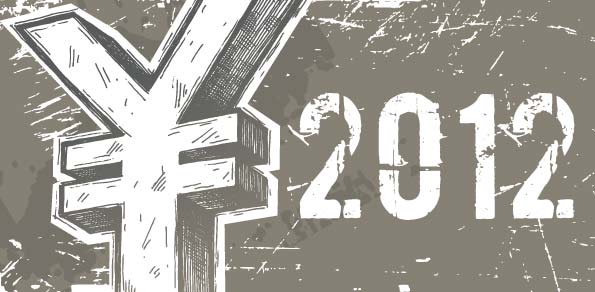Japan sold at least 14.3 trillion yen ($183 billion) in 2011 in order to stem the gains that cut profits for exporters, Finance Minister Jun Azumi has pledged more intervention if required in 2012. Intervention in 2012 may fail again however, as the financial turmoil in the USA and Europe attracts investors to the world’s third-most traded currency due to its relatively low volatility.
The yen has advanced versus most major currencies in 2011, including a 4.1 percent rise versus the USA dollar. Despite bond yields in Japan being the second-lowest in the ‘developed’ world and government borrowings being double the size of the economy, foreign ownership of its debt is now at the highest point since 2008.
Besides its gains versus the dollar, (the world’s reserve currency), the yen is the best performer of 2011 after ‘filtering out’ price swings, strengthening 0.5 percent, according to the risk-adjusted return data compiled by Bloomberg. The Yen is the only Group of 10 currencies predicted to rise versus the greenback next quarter, strengthening to 77 per dollar by March 31, many analysts’ forecasts show. The U.K. pound and Swiss franc were the second and third best performers versus the dollar in 2011, finishing unchanged and down by 0.1 percent on a risk-adjusted basis. South Africa’s rand fared the worst, weakening 1 percent after taking into account price swings, followed by the Mexican peso’s 0.7 percent loss.
Gains in Japan’s currency underscore the retreat from risk and losses in carry trades, whereby investors borrow in low- interest regimes to invest in higher-risk, higher-return assets elsewhere. Carry trades involving borrowing yen to invest in the currencies of Australia, South Africa, Mexico and Brazil have lost 9.1 percent this year, reversing a 1 percent gain in 2010.
The Japanese currency traded at 77.90 per dollar and 101.82 versus the euro as of 9:02 a.m. London time. For the year, the yen advanced 4.1 percent versus the greenback and 6.6 percent versus the 17-nation currency.
The difference in the number of positions by hedge funds and other large speculators on a rise in the yen compared with those predicting a drop was 24,476 on Dec. 20, data from the Washington-based Commodity Futures Trading Commission revealed? In April there was a net 52,983 contracts betting on a fall.
Japan’s nominal gross domestic product is roughly the same as 1992, following the collapse of the nation’s asset and real estate bubble. The Bank of Japan on Oct. 27 lowered its forecast for the country’s economic growth in 2012 to 2.2 percent from the 2.9 percent projected in July, citing effects from the strong yen. A previous yen record of 79.75 reached in April 1995 stood until March of this year, when a magnitude-9.0 earthquake struck Japan’s northeast, stoking speculation companies would repatriate overseas assets to pay for rebuilding. The currency jumped to 76.25 on March 17, prompting coordinated action by Group-of-Seven nations the next day.
Total currency sales in the year through Nov. 28 were seven times bigger than the 2.1 trillion yen sold in one event in 2010, according to data from the Ministry of Finance. The currency erased most losses in as short as five days after each intervention and stood about 12 percent stronger on Dec. 23 than the three-year average against the dollar. Lack of alternative havens is causing investors to buy and hold. Three-month historical volatility in the dollar-yen rate was at 9 percent today, the least since July and compared with a three-year average of 12 percent. The 10.18-yen gap between the Japanese currency’s weakest and highest points of 2011 is the narrowest since at least 1973 when it started to trade freely.
Market Overview
The volume of shares changing hands across Europe is reduced today as U.K. and Irish markets remain closed for a second day following the Christmas holiday. European stocks advanced for a third day before reports from 2:00 pm GMT that may show house prices in U.S. cities fell at a slower pace and consumer confidence climbed. Asian shares retreated.
The benchmark Stoxx Europe 600 Index climbed 0.2 percent to 242.31 at 10:20 a.m. in London. The MSCI Asia Pacific Index declined 0.2 percent as the Bank of Japan warned of risks to the economy and South Korean consumer confidence slid. U.S. index futures will begin trading at 6 a.m. New York time today after the Christmas holiday, according to the IntercontinentalExchange Inc. website.
Stock swings that reached twice the five-decade average left the S&P 500 with the smallest price change in 41 years. The S&P 500 rose 3.7 percent last week, sending the measure to a gain of 0.6 percent for the year. The last time it moved less on an annual basis was in 1970, when it fell 0.1 percent.
Economic calendar releases that could affect sentiment in the afternoon session
Tuesday 27 December
14:00 US – S&P/Case-Shiller Home Price Indices Oct
15:00 US – Consumer Confidence December
15:00 US – Richmond Fed Manufacturing Index Dec
A Bloomberg survey gives a median consensus of -3.23% falls in house prices year-on-year for the Composite-20, from a previous reading of -3.59%. A Bloomberg survey of economists forecasts a figure of +58.3 for consumer confidence as compared with the previous reading of +56. A survey gives a median consensus of 5 for the Richmond Fed figure, compared to the previous reading of 0.





